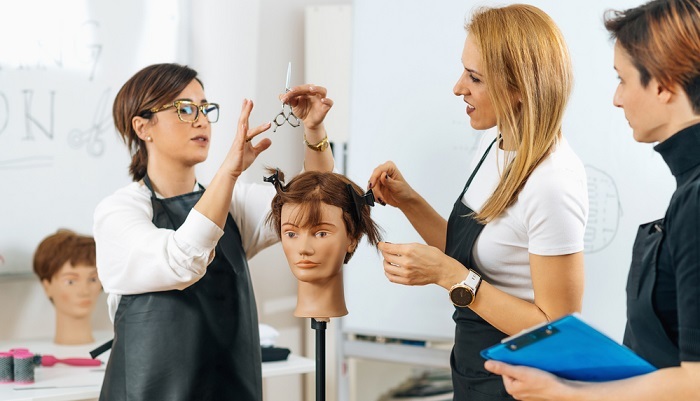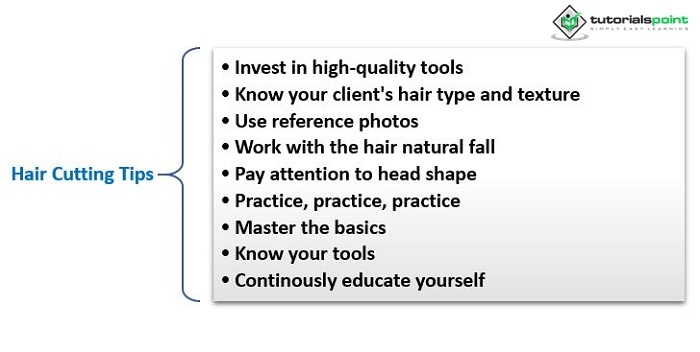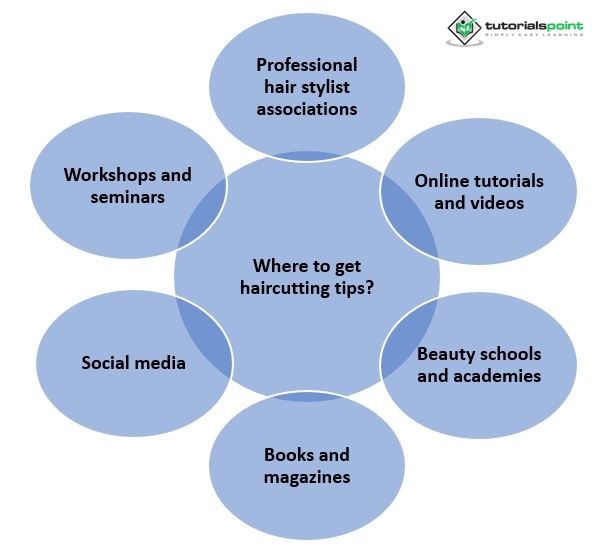
 Data Structure
Data Structure Networking
Networking RDBMS
RDBMS Operating System
Operating System Java
Java MS Excel
MS Excel iOS
iOS HTML
HTML CSS
CSS Android
Android Python
Python C Programming
C Programming C++
C++ C#
C# MongoDB
MongoDB MySQL
MySQL Javascript
Javascript PHP
PHPPhysics
Chemistry
Biology
Mathematics
English
Economics
Psychology
Social Studies
Fashion Studies
Legal Studies
- Selected Reading
- UPSC IAS Exams Notes
- Developer's Best Practices
- Questions and Answers
- Effective Resume Writing
- HR Interview Questions
- Computer Glossary
- Who is Who
Haircutting Techniques & Tips
Always use sharp, professional-grade tools and understand your client's hair type and texture. Refer to reference photos, consider head shape, practice, and master the basics. Work with the hair's natural fall and keep your tools sharp. Continuously educate yourself to stay up-to-date on new techniques and trends.

Why Should One Follow Basic Tips While Haircutting?
Following basic tips while haircutting is important because it ensures a good outcome and a satisfied client. Some of the reasons why one should follow basic tips while haircutting include −
Consistency − Basic tips provide a consistent and reliable foundation for cutting hair, ensuring that the end result is always of a high standard.
Safety − Following these basic tips can help prevent accidental cuts or injuries to the client or yourself.
Precision − Basic tips provide a step-by-step guide for ensuring precise cuts, which are essential for achieving a professional and polished look.
Confidence − Knowing that you are following established, tried-and-true methods can increase your confidence when cutting hair, which in turn leads to better results.
Time management − Following these basic tips helps ensure that you use your time efficiently, so you can finish the cut in a timely manner and move on to the next client.
Client satisfaction − By following these basic tips, you are more likely to provide a good haircut that meets the client's expectations, which can lead to increased client satisfaction and repeat business.
Haircutting Fundamentals
Here are some basic tips for cutting hair −
Make sure the hair is clean and dry before starting.
Use sharp, professional-grade hair cutting tools, such as shears and combs.
Section the hair into manageable sections, starting with the bottom layers and working your way up.
Start with a small amount of hair and gradually cut more as needed.
Use your fingers as guides to create even layers.
Take your time and work methodically, making small cuts rather than trying to take too much off at once.
Blend the layers gradually to ensure a smooth, even look.
Use the right cutting technique for the desired style. For example, point cutting creates textured ends, while slicing creates a smooth, gradual look.
Check the haircut from all angles, including the back, to make sure it's even and symmetrical.
Trim any stray or uneven hairs after the initial cut.
Remember, it's always better to err on the side of caution when cutting hair, as it can be difficult to fix if you cut too much. If you're unsure about a cut, take a break and assess the situation before continuing.
Hair Cutting Tips
Here are some pro tips for hair cutting −

Invest in High-quality Tools − Good tools make a big difference in the quality of your cuts. Invest in high-quality hair shears, combs, and brushes.
Know your client's Hair Type and Texture − Understanding the hair type and texture of your client is crucial in determining the best cutting techniques and products to use.
Use Reference Photos − Before starting the cut, have your client show you photos of their desired hairstyle. This will help ensure you both have a clear vision of the end result.
Pay Attention to Head Shape − Consider the shape of your client's head when cutting their hair. This can affect how the hair falls and the overall look of the cut.
Practice, Practice, Practice − The more you do it, the better you'll get. Cut hair on friends, family, and yourself to improve your skills and try new techniques.
Master the Basics − Before moving on to more advanced techniques, make sure you have a solid understanding of the basics of hair cutting.
Know your Tools − Each tool has a specific purpose and function. Know what each tool does and how to use it correctly to get the best results.
Work with the Hair's Natural Fall − Rather than fighting against the hair's natural fall, work with it to create a cut that is both stylish and easy to maintain.
Keep your shears sharp − Dull shears can cause jagged, uneven cuts. Keep your shears sharp to ensure clean, precise cuts every time.
Continuously educate yourself − The world of hair cutting is constantly evolving, so it's important to continue educating yourself and staying up-to-date on new techniques and trends.
Why Does Haircutting Practice Matter?
Practice is important in haircutting for several reasons.
Skill Development − By practicing on various hair types and textures, you can refine your techniques and improve your skills, which can lead to better results and increased confidence.
Familiarity with Tools − Practicing allows you to become familiar with your tools, such as shears and combs, and how to use them effectively.
Experimentation − When practicing, you have the opportunity to try new techniques and styles to expand your knowledge and skillset.
Perfection − No one is perfect, and mistakes are bound to happen, but practicing can help you identify and correct mistakes and become a more proficient cutter.
Adaptation − Practicing on a variety of hair types and textures can help you become more adaptable and confident in working with different clients.
Staying Current − By regularly practicing, you can stay current on the latest hair cutting techniques and trends, which can keep your skills fresh and relevant.
In short, practicing is essential for improving your skills and confidence in hair cutting and ultimately providing better results for your clients.
Where can I Get Haircutting Tips?
There are several sources for obtaining haircutting tips, including −

Professional Hair Stylist Associations − Professional hair stylist associations, such as the Professional Beauty Association, offer education, resources, and training for hair stylists to improve their skills.
Online Tutorials and Videos − There are numerous online tutorials and videos available that demonstrate different haircutting techniques, styles, and tips.
Beauty Schools and Academies − Beauty schools and academies offer courses and training in hair cutting, which can provide hands-on experience and instruction from experienced hair stylists.
Books and Magazines − Books and magazines, such as beauty and hair styling publications, offer tips, techniques, and advice for hair cutting.
Social Media − Social media platforms, such as Instagram and YouTube, are great places to find inspiration and tips for hair cutting, as well as to connect with other hair stylists.
Workshops and Seminars − Workshops and seminars offer in-person training and instruction from experienced hair stylists, providing hands-on experience and the opportunity to ask questions and learn from the experts.
Conclusion
Hair cutting is an important skill that requires practice, patience, and dedication to master. By following these basic tips, practicing regularly, and continually educating yourself, you can develop your skills and confidence in hair cutting and provide better results for your clients. Whether you are a beginner or an experienced hair stylist, there is always room for improvement, so take advantage of the many resources available and continue to grow and evolve in your craft.

